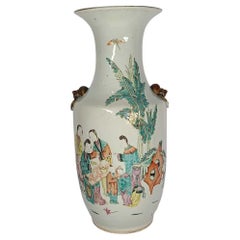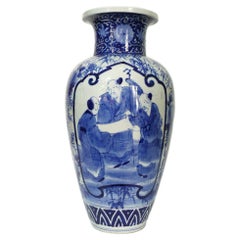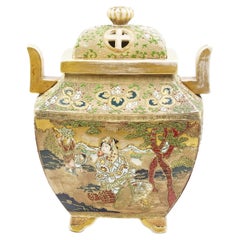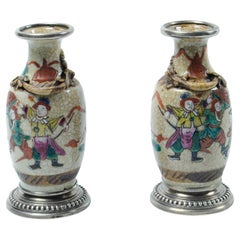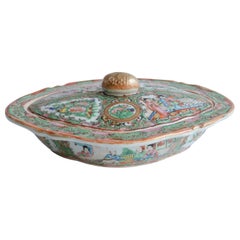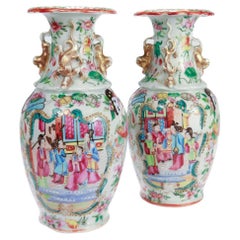Saint John Ceramics
to
2
5
5
3
2
3
2
4
3
2
2
1
5
5
4
1
5
5
5
Chinese vase
Located in Buenos Aires, Argentina
Chinese vase
Famille Rose
Pink, green, and ochre colors.
It has a pair of handles with gold and orange lion masks.
Circa 1900
Origin: China
Hand-painted porcelain
Wear consistent wi...
Category
Antique Early 1900s Chinese Chinese Export Ceramics
Materials
Ceramic
$1,600
Chinese Qing Dynasty Vase
Located in Buenos Aires, Argentina
Chinese Qing Dynasty Vase
Circa 1900 Origin China
Decoration with traditional scenes
(1644 - 1911)
Glazed and enamelled technique
Blue and white colour
Po...
Category
Antique Early 1900s Chinese Chinese Export Ceramics
Materials
Enamel
Koro Satsuma Japanese ceramic
Located in Buenos Aires, Argentina
Koro Satsuma Japanese ceramic
Japanese glazed ceramic in various colors
Meiji Style Circa 1940 Origin Japan
It has traditional images painted on its front and back.
The purpose of th...
Category
Vintage 1940s Japanese Meiji Ceramics
Materials
Enamel
Pair of Chinese Amphoras -miniatures-
Located in Buenos Aires, Argentina
Pair of Chinese amphoras -miniatures-
ceramic with mount -ring- in European silver
Origin China, circa 1900
perfect condition
warrior scenes.
Category
Antique Early 1900s Chinese Chinoiserie Ceramics
Materials
Silver
$720 Sale Price
20% Off
Oval Chinese Pea with Lid
Located in Buenos Aires, Argentina
Oval Chinese pea with lid
Origin Canton China for export
circa 1940 hand painted.
Category
Vintage 1940s Chinese Chinoiserie Ceramics
Materials
Porcelain
$368 Sale Price
20% Off
Related Items
Chinese Export Octagonal Plate, Qing Dynasty, Qianlong Period
Located in West Palm Beach, FL
Chinese Export Octagonal Plate, Qing Dynasty, Qianlong Period
Qing Dynasty, Qianlong Period, circa 1790
An exquisite Chinese export octagonal plate from the Qing Dynasty, Qianlong P...
Category
Antique 18th Century Chinese Chinese Export Ceramics
Materials
Porcelain
$760 Sale Price
20% Off
H 1 in W 8.5 in D 8.5 in
Pair of Antique Chinese Export Rose Mandarin Vases
Located in Philadelphia, PA
A pair of fine antique Chinese porcelain vases
In the Rose Medallion style.
With 4 gilt handles around the neck in the form of foo dogs and lizards.
The mouth/rim of the vase is f...
Category
Early 20th Century Chinese Chinese Export Ceramics
Materials
Porcelain
Chinese Speckle Glazed Onion Shape Bottle Shaped Vase
Located in Bishop's Stortford, Hertfordshire
A fine quality Chinese onion shape bottle vase decorated in mottled glazes dating from the latter 19th or 20th century. The stoneware vase stands raised on a narrow round foot and ha...
Category
Early 20th Century Chinese Chinese Export Ceramics
Materials
Stoneware
Chinese Peachbloom Oxblood Porcelain Amphora Style Vase - Kangxi Mark
Located in Atlanta, GA
Chinese. A porcelain peachbloom oxblood porcelain vase with fitted base.
Kangxi type mark to underside.
Approx: 8.25" H X 2.5" W.
Category
20th Century Chinese Chinese Export Ceramics
Materials
Porcelain
$716 Sale Price
20% Off
H 8.25 in W 2.5 in D 2.5 in
Pair of Chinese Export Porcelain Lamps
Located in Lambertville, NJ
A pair of hand painted Chinese porcelain lamps with simple carved wood bases. These are in a classic Rose Medallion pattern. The wiring is in great condition and ready to use. The sh...
Category
Mid-20th Century Chinese Chinese Export Table Lamps
Materials
Porcelain
Antique Blue White Chinese Porcelain Qing Dynasty Kangxi Period Dragon Vase 1680
Located in Portland, OR
A very large & rare antique Chinese Qing Dynasty Blue & White Porcelain Rouleau dragon vase, Kangxi period (1662-1722), the vase dating to the late 1600s.
The vase of slightly tapere...
Category
Antique 1680s Chinese Qing Ceramics
Materials
Porcelain
$6,800
H 19 in Dm 6 in
Monumental Pair Antique Chinese Qing Dynasty Famille Rose Porcelain Vases 1900
Located in Portland, OR
A fine pair of Monumental antique Chinese late Qing dynasty period Famille Rose Porcelain vases.
The vases of baluster form with applied handles modeled as dragons, each vase is very finely a hand-painted with polychrome scenes of immortal figures in a garden setting. Each vase having a red Qianlong six character mark to the base. Excellent condition, no damage or retoration.
This monumental pair of antique...
Category
Antique Early 1900s Chinese Qing Ceramics
Materials
Porcelain
$3,840 Sale Price / set
20% Off
H 26.5 in Dm 13 in
Exquisite Japanese Satsuma Vase by Seikozan
Located in Atlanta, GA
A miniature vase in elegant upright form reminiscent of the Chinese imperial Willow Leaf form made by Japanese studio Seikozan circa 1890-1910s (late Meiji Period). One of the many a...
Category
Antique 1880s Japanese Meiji Ceramics
Materials
Ceramic
Pair of Chinese Blue and White Jars with Lids
Located in Bradenton, FL
Pair of Chinese blue and white vases with lids.
Category
20th Century Chinese Chinese Export Ceramics
Materials
Porcelain
Chinese Qing Dynasty Flambé Glazed Bottle Vase, Tianqiuping, Late 19th Century
Located in Austin, TX
A gorgeous Chinese monochrome red flambé glazed bottle vase, called a tianqiuping, Qing Dynasty, late 19th century.
The voluptuous body o...
Category
Antique Late 19th Century Chinese Qing Vases
Materials
Porcelain
$6,500
H 14 in Dm 9.5 in
Pair Chinese White Glazed Guanyin, Qing Dynasty, 18th Century, China
Located in Austin, TX
A sublime and rare pair of Chinese white glazed porcelain figures of Guanyin, attributed to Tang Ying (1682 - 1756), Qing Dynasty, Qianlong Period, China.
This ethereal pair of white glazed porcelain figures depict the revered Buddhist Goddess of Mercy, Guanyin. Guanyin is portrayed standing, wearing heavy robes that drape beautifully around her figure. Bare feet peek out from under the hem of the robes. Her hair piled in a high chignon and covered by a cowl. The treatment of the hair, finely textured, unglazed, and with remnants of darker pigment, is typical of works by Tang Yin (1682 - 1756), who was the head of the imperial porcelain works at Jingdezhen.
Guanyin's beatific face is set in a serene smile, with a small, flat nose, and downcast, heavily lidded, almond shaped eyes. A simple beaded necklace graces her chest. Her hands held out, and may have once held attributes.
The hands were originally removable, but have since been permanently attached.
The figures crafted of a fine porcelain and glazed all over in a supple white glaze.
One figure bears a label from the Rafi Mottahedeh collection to the back.
Provenance:
Chinese Porcelain Company...
Category
Antique 18th Century Chinese Qing Ceramics
Materials
Porcelain
$21,000 / set
H 13.25 in W 5 in D 4 in
Late 19th Century Qing Dynasty Matching Pair Chinese Famille Rose Vases
Located in Silvolde, Gelderland
Beautiful set of two matching Qing Dynasty porcelain vases. These vase are both in good condition and add absolute great value to your interior.
Category
Antique Late 19th Century Chinese Chinese Export Ceramics
Materials
Porcelain
$1,486 / set
H 16.93 in Dm 7.49 in
